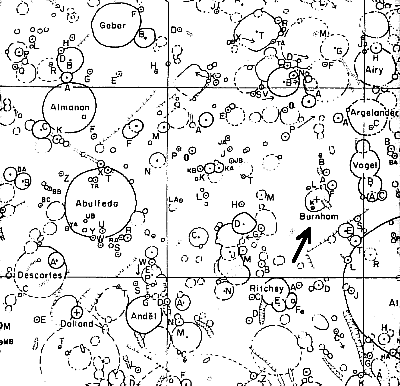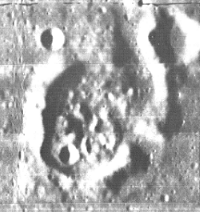Map of the Area


The Burnham sunrise ray, as seen by Jay Reynolds Freeman, is another lunar phenomena worth some attention. Jay knew of no other reports of this event being seen. Below are some of his observation reports, the ephemeris table for when this even may next be seen, and a map with an area description. Any further reports that are received I will post along with Jay's observations.
From: freeman@netcom.com (Jay Reynolds Freeman)
Date: Wed, 14 May 1997 17:25:57 GMT
Several San Francisco Bay area observers saw the apparition of the
Burnham sunrise ray, which had been predicted for about 0230 UT on 14
May, 1997.
I myself first looked for the ray at 0230, from outside my residence
in Palo Alto, California, with a 63 mm f/5.6 Brandon refractor at 142x,
but did not see it. Sky conditions were not good -- the Sun was still
up, there was thin, high cirrus, and the seeing was terrible. Also, the
ray may not have started yet.
Later in the evening, I joined a scheduled "close-in" star party in
the hills of the San Francisco Peninsula that overlook Palo Alto. At
0430 UT, the apparition was still in progress, and very pretty through
several instruments: We could see the ray easily in a 6-inch f/8 Cave
Astrola at 75x, in a 70 mm Tele Vue Pronto at 98x, and in an 8-inch
Celestron Ultima 2000 at 267x. By that time the walls of Burnham and
much of the high terrain a little to the (Selenographic) west were
illuminated by direct sunlight, but the low plain immediately to the
west was still in shadow, and the ray lay across it, clearly visible as
a fine streak of light, looking almost luminous.
A couple of the observers present were confused about exactly where
the ray was: Being familiar with the brighter and easier Hesiodus
sunrise ray, they were expecting a ray that trailed from a crater wall
*into* a crater. But the Burnham ray lies outside the walls of Burnham,
between the crater and the terminator.
Not much happens on the Moon, but low sun-elevation rays such as
these are fun to chase down and look at.
Burnham, +122 -242 [American astronomer, 1838-1921]. This object is a ring with low walls, at the north end of a long valley which runs southwards to a ring on the west of Airy. On the interior of Burnham are a crater and two hills. There is a small mountain on the outer, north-east wall.

